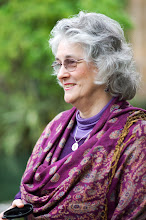 |
| Steineset Witchcraft Memorial in Vardø, Finnmark, Norway |
Contemporary Pagan
Studies Unit
Pagan Intersections
with Social and Cultural Systems.
These papers investigate the ways in which Pagan belief and practices intersect
with wider aspects of culture and experience and the ways in which Pagans
themselves interact with services and institutions. Topics include the impacts of being Pagan on health and
wellbeing and the ability to see appropriate care and diagnosis, the impacts of
Pagan leadership in environmental activism, and how a pilgrimage site is used
for educational purposes.
«
Kimberly
Kirner – Seeking Healing and
Support: Mental and Physical
Health Challenges in Pagan Communities. Pagans are known for high rate of small-group and solitary
practice, often facilitated at people’s homes or public spaces such as national
forests and parks. How does this
impact how Pagans with mental and physical health challenges experience their
communities? How does Pagan community color their experience of support in
seeking care and treatment for their health challenges? The 2012 Pagan Health Survey asked
United States Pagans about their beliefs, practices, and experiences in healing
(N+1811). 76% of respondents
reported a period in their lives of significant mental distress or disorder
(with 54% having experienced depression, 60% anxiety or panic, and 29% PTSD);
49% of respondents reported a chronic physical illness. This paper explores how Pagans with
such health challenges experience their religious community, including both
support and discrimination, as well as how multiple stigmas (religious minority
combined with frequently stigmatized health challenges) impacts Pagans’
well-being.
«
Garrett
Sadler – Seeking Healing and
Support: Mental and Physical
Health Challenges in Pagan Communities.
«
Jeffrey
Albaugh – A Phenomenological
Exploration of Theophany and Metanoia in Contemporary Paganisms. This descriptive phenomenological
inquiry explores invariant structures of meaning in the lived experiences of
theophany and metanoia in individuals identifying as Contemporary Pagans in the
United States. Methods of inquiry
included open-ended questions to collect descriptions of numinous
experiences. Analysis utilizes the
descriptive phenomenological method developed by Amedeo P. Giorgi, and compares
the resulting invariant meanings with the current research on Contemporary
Pagan belief and practice.
Analysis resulted in a predictable map of the psychic experience of
encountering the numinous that mirrors the four basic tropes of archetypal
psychology, personifying, of imagining things; pathologizing, or falling apart;
psychologizing, or seeing through; and dehumanizing, or soul making.
* * * * *
I was amazed, pleasantly so, to learn of this spectacular memorial installation in Norway, of all places. Who knew there were Witch burnings in Norway? I didn’t. From the various photos online, it appears that the visitor could be drawn in to the experience of events. I think you can tell a lot from the photos included here.
 |
| Burning Chair |
 |
| Chair at Nighttime |
 |
| Distant View |
 |
| It's Right Out There Along the Cliff |
 |
| Another View Showing Waves |
«
Jone
Salomonsen and Sarah M Pike – Presence
and Absence at the Steilneset Witchcraft Memorial. Where do we find
memorials to commemorate early modern witch hunts as a crime, and to more the
many thousands who were tortured and killed as heretics in Europe (and North
America)? How does a state
incorporate its crime against those deemed and burned as devilish others into
its memorial landscape? According
to contemporary memory studies, the time of the monument is passé. Rather than embodying memory, the
monument tends to displace it altogether, supplanting a community’s possible
memory work with its own material form.
The alternative to “monument” is the “memorial,” which is defined as a
counter-monument, a built structure in which the artist has attempted a performative
piece that may initiate a dynamic relationship between artist, work and
viewer. A memorial, therefore, is
an egalitarian conception that attempts not only to commemorate the historical
impulse that led to the abuse, the kill, the event “itself,” but to facilitate
an enactment in which the hierarchical relationships between the object and its
audience is breaking down. The
enactment in which the hierarchical relationship between the object and its
audience is breaking down. The
paper will present and discuss the one case in which a local municipality
recognized its obligation to remember the early modern witch burnings in its
own town and who called on world-renowned artists to design a worthy site. Steineset Witchcraft Memorial in Vardø,
Finnmark, in northern Norway, is also a unique sample of an embodiment of the
conceptual intent of a ‘memorial.’
The actual memorial is a 2011 co-production by the Swiss architect Peter
Zumthor and the French-American installation artists Louise Bourgeois to
commemorate 77 women and 14 men who were burned at the stake between 1620 and
1692 in this sparsely populated county (of 3000 inhabitants at the time in
Northern Norway.
 |
| Another View |
 |
| The Long Walk to the Fire |
 |
| Long Walk to Fire Chair |
 |
| Nighttime |












3 comments:
cOOL PICTURE YOU HAVE HERE.GREAT!!!
NegosyongPinoy.info
Hi
I am glad I discovered this blog. I really like what you been writing! I think there is much more to this, though.
My best wishes!
Aroniaberry.ca
This blog post provides fascinating insights into how memorials can commemorate and process historical events.
Post a Comment